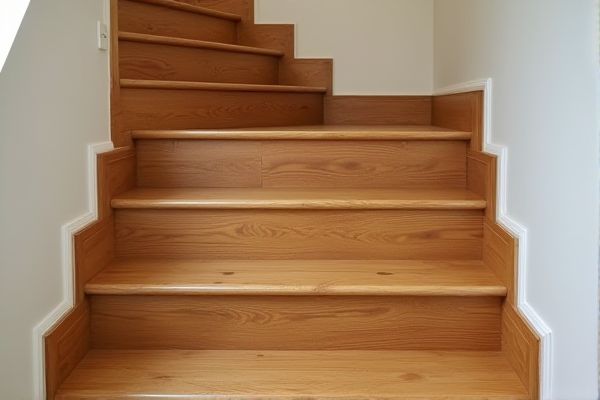
Oak steps offer exceptional durability and a rich, warm appearance, making them ideal for high-traffic areas, while maple steps provide a lighter, smoother finish with a subtle grain that suits modern interiors. Discover how choosing between oak and maple steps can transform your home's staircase by exploring the detailed comparison in the article.
Table of Comparison
| Feature | Oak Steps | Maple Steps |
|---|---|---|
| Durability | High; very resistant to wear and dents | Moderate to high; harder than many woods but less than oak |
| Grain Pattern | Prominent, coarse grain with a rustic look | Smoother, fine grain with uniform texture |
| Color | Light to medium brown with reddish hues | Light cream to pale golden brown |
| Cost | Moderate; widely available and affordable | Typically higher; less abundant and more premium |
| Maintenance | Requires periodic sealing and polishing | Also requires sealing; may show scratches more readily |
| Suitability | Ideal for traditional and rustic designs | Preferred for modern and sleek aesthetics |
Introduction to Oak and Maple Steps
Oak steps offer exceptional durability and a distinct grain pattern that enhances traditional and rustic interior designs. Maple steps are known for their smooth, fine texture and lighter color, creating a clean, modern aesthetic while providing strong resistance to wear. Both hardwood options provide excellent structural integrity, but oak tends to be harder and more resistant to dents compared to maple.
Key Differences Between Oak and Maple Wood
Oak steps feature a prominent grain pattern and a coarse texture, providing a more rustic and traditional look, while maple steps boast a fine, uniform grain with a smooth surface ideal for modern and sleek designs. Oak is generally harder and more durable, with a Janka hardness rating of about 1,290, compared to maple's 1,450, making maple slightly more resistant to dents and wear. The color variations in oak range from light tan to reddish-brown, whereas maple tends to be lighter with cream or pale reddish hues, affecting the final aesthetic of the flooring.
Durability and Strength Comparison
Oak steps exhibit remarkable durability and strength due to their dense grain structure, making them highly resistant to wear and impact. Maple steps, known for their hardness and tight grain, provide excellent strength but may be more susceptible to dents compared to oak in high-traffic areas. Both hardwoods offer robust performance, with oak slightly outperforming maple in longevity and resistance to heavy use.
Appearance and Grain Patterns
Oak steps feature a distinctive, prominent grain pattern with bold, swirling lines that create a rustic and textured appearance, making them ideal for classic or traditional interiors. Maple steps offer a smoother, more uniform grain with subtle patterns and a lighter, creamy color that lends a modern, clean, and sleek look to your staircase. Choosing between the two depends on whether you prefer the striking character of oak or the understated elegance of maple for your home's aesthetic.
Color Variations in Oak and Maple Steps
Oak steps display a wide range of color variations, from light golden hues to rich reddish-brown tones, offering a versatile option for different interior styles. Maple steps tend to have a more consistent, lighter color palette, typically creamy white to pale reddish-brown, which can brighten your space and create a clean, modern look. Choosing between oak and maple steps depends on whether you prefer the bold, varied grains of oak or the subtle, uniform appearance of maple.
Cost and Affordability Analysis
Oak steps typically cost between $40 and $70 per step, making them a budget-friendly option for many homeowners, while maple steps range from $60 to $90 per step due to their denser grain and durability. The affordability of oak is enhanced by its widespread availability and ease of finishing, whereas maple's higher price reflects its superior hardness and resistance to wear. Factoring in installation and longevity, oak steps represent a cost-effective choice, but maple steps may offer better long-term value in high-traffic areas.
Maintenance and Longevity
Oak steps generally require less maintenance due to their natural resistance to wear and moisture, making them a durable choice for high-traffic areas. Maple steps, while harder and more scratch-resistant, may need more frequent refinishing to maintain their appearance and protect against dents. Both hardwoods offer long-lasting durability, but oak tends to provide a balance between ease of care and extended longevity in residential settings.
Installation Considerations
Oak steps require careful acclimation to prevent warping due to their denser grain structure, while maple steps demand precise moisture control during installation to avoid cracking. Both wood types benefit from professional fitting and secure fastening to ensure longevity and safety in your stairway. Proper subfloor preparation and adhesive selection are crucial factors affecting the performance of either oak or maple steps in your home.
Best Use Cases for Oak vs Maple Steps
Oak steps offer exceptional durability and grain texture, making them ideal for high-traffic areas such as stairways in commercial buildings and rustic home designs. Maple steps provide a smooth, fine grain and a lighter color palette, perfect for modern interiors requiring a sleek, consistent finish and resistance to wear in residential staircases. Choosing oak or maple hinges on aesthetic preference, foot traffic expectations, and the desired durability for the intended space.
Environmental Impact and Sustainability
Oak steps generally have a lower environmental impact due to their slower growth rate and greater durability, reducing the need for frequent replacement. Maple steps come from faster-growing trees, which can contribute to more sustainable forestry practices, but their shorter lifespan may increase waste over time. Your choice between oak and maple steps should consider the balance between sustainable sourcing and long-term environmental benefits.
 homyna.com
homyna.com